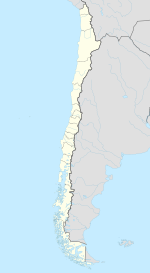Combarbalá
| Combarbalá | |||||
|---|---|---|---|---|---|
| City and Commune | |||||
|
|||||
| Coordinates (city): 31°11′0″S 71°00′0″W / 31.18333°S 71.00000°WCoordinates: 31°11′0″S 71°00′0″W / 31.18333°S 71.00000°W | |||||
| Country |
|
||||
| Region |
|
||||
| Province | Limarí | ||||
| Founded | November 30, 1789 | ||||
| Government | |||||
| • Type | Municipality | ||||
| • Alcalde | Solercio Rojas Aguirre (PRI) | ||||
| Area | |||||
| • Total | 1,895.9 km2 (732.0 sq mi) | ||||
| Elevation | 904 m (2,966 ft) | ||||
| Population (2012 Census) | |||||
| • Total | 13,605 | ||||
| • Density | 7.2/km2 (19/sq mi) | ||||
| • Urban | 5,494 | ||||
| • Rural | 7,989 | ||||
| Sex | |||||
| • Men | 6,695 | ||||
| • Women | 6,788 | ||||
| Time zone | CLT (UTC−4) | ||||
| • Summer (DST) | CLST (UTC−3) | ||||
| Website | Municipality of Combarbalá | ||||
Combarbalá is the capital city of the commune of Combarbala. It is located in the Limarí Province, Region of Coquimbo, at an elevation of 900 m (2,952 ft)). It is known for the tourist astronomic observatory Cruz del Sur; the petroglyphs of Rincon las Chilcas; its typical handcraft made of the unique combarbalita stone; the classical basketball match at the end February; the Virgen de la Piedra catholic-pagan festivity, among other tourist attractions.
There are two hypotheses that might to explain the origin of the name "Combarbalá". Both hypothesis are rooted in the Spanish transliteration of the aborigine name of the area. The first hypothesis holds that the word Combarbalá is derived from the Quechua word "Cumparpayay", which means "to break with a hammer", and designates the usual labor for obtaining minerals and stones from mines.
The second hypothesis holds that the origin of the word Combarbalá comes from the Mapudungun word "Co Cam Bala", where "Co" means Water, "Cam" means Far, and "Bala" means Duck. Thus, Cocambala literally means "far away water with ducks", or Duck's pond. In fact, there is a place known as Duck's pond very near to the city. This pond was used as a resting place by the Inca army in their advance to the south, and then by the Spanish conquistadores Diego de Almagro first, and later by Pedro de Valdivia.
People of Combarbalá likes to make jokes about the name of the city: they hold that an aborigine of the area, who was named "La", left to travel with the Spaniards. "La" got used to shaving his face and returned with a dense beard, something unusual because South American aborigines don't grow beards. Because of this, people named the area as the place where "Con-Barba-La" —literally with-beard-La or bearded La—lived. This history is told for the amusement of children's during the celebration of the city foundation anniversary.
The geographical area where Combarbalá is located was originally populated by Molle, Diaguita and Inca people. Molle people were the first to inhabit the area. The Molle people were hunter-gatherers, although they also practiced some primal forms of agriculture. They inhabited the area from c. 400 B.E.C. to c. 900 E.C. Their origins are still unknown, although some hypothesis trace them back to the Amazon Rainforest, coming through what is now Bolivia to the Atacama and Coquimbo regions of Chile.
...
Wikipedia



